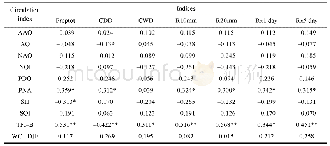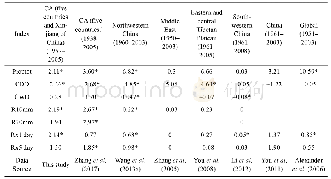《Table 4 Comparison of reconstructed precipitation (P) extremes with data on historical events》
 提示:宽带有限、当前游客访问压缩模式
提示:宽带有限、当前游客访问压缩模式
本系列图表出处文件名:随高清版一同展现
《"Dynamics of moisture regime and its reconstruction from a tree-ring width chronology of Pinus sylvestris in the downstream basin of the Selenga River, Russia"》
Note:Plus(+)represents positive P extremes,and minus(–)represents negative ones.
Many extremes of both signs of the reconstructed P outside the instrumental data period are confirmed by historical sources(Table 4).For example,some maxima are consistent with the reports on floods from high water or heavy rains in Transbaikalia and Irkutsk provinces.Kozhuhov(1967)mentioned that\""1801,1811,1820,1830,1840,and 1848 were the most severe years for agriculture\"".There is also stated that in 1802,in Transbaikalia\""due to lack of bread in the summer time,people were fed with the quinoa and other grasses\"";in 1809\""the settlers suffered a calamity of bad harvest\""which lasted several years;\""crop failure continued for several years and almost all Transbaikalia suffered from it in 1811 and during the period 1813–1816\"";\""from the bad harvest of grass and the lack of a forage feed in September 1838,cattle began to die...\"".Poor harvests of 1811–1816 were also mentioned by Shcheglov(1884).As reconstructed P showed,bad harvest could have been caused by drought,as well as by heavy spring-summer rains.Besides that,catastrophic fire of 1879 in Irkutsk was also drought-related(Kudryavtsev and Vendrih,1971).May and June of that year were extremely hot and dry,and when fire ignited(22and 24 June)the weather was also very hot,which made fire-fighting difficult.As a result,the fires produced a huge devastation,more than half of the city was destroyed(Antonov,1996).
| 图表编号 | XD0020364600 严禁用于非法目的 |
|---|---|
| 绘制时间 | 2018.12.01 |
| 作者 | Liliana BELOKOPYTOVA、Dina ZHIRNOVA、Tatiana KOSTYAKOVA、Elena BABUSHKINA |
| 绘制单位 | Khakass Technical Institute, Siberian Federal University、Khakass Technical Institute, Siberian Federal University、Khakass Technical Institute, Siberian Federal University、Khakass Technical Institute, Siberian Federal University |
| 更多格式 | 高清、无水印(增值服务) |
查看“Table 4 Comparison of reconstructed precipitation (P) extremes with data on historical events”的人还看了
-

- Table 7 The correlation coefficient values between precipitation extremes in CA and atmospheric circulations
-

- Table 5 Abrupt change of extreme precipitation indices based on the test results of cumulative deviation and student’s t





